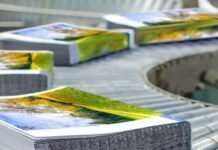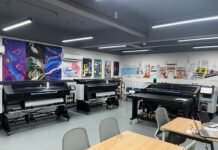
The Merriam-Webster dictionary defines letterpress as ‘the process of printing from an inked raised surface, especially when the paper is impressed directly upon the surface.’ Also called relief printing, or typographic printing, the letterpress printing process has been employed for centuries to print images and text on paper. However, it is a time and labor-intensive process that requires hours of hard work and skill in order to be successful.
The credit for inventing the letterpress (originally a wooden wine press) and movable or reusable metal type goes to Johannes Gutenberg, who brought the machine to the market for commercial use in the year 1455, although similarly used ceramic type existed in Korea and China earlier. In the 16th to 20th centuries, letterpress machines allowed for the mass production of books, religious texts, and newspapers – making them much more affordable. The requirements of the newspaper industry lead to the invention of the linecaster in the 19th century and displaced monocasters to some extent but type foundries continued to rely on monocasters. This brought about a printing revolution in Europe, and around the world, involving massive changes to how information was disseminated. Prior to this, even the Bible was accessible only to priests, with no access to the common man.
Letterpress printing is an expensive process requiring specialized equipment and skilled manual labor. The transfer of text involves pressing ink into paper through the pressure applied to the metal type in a chase or in the case of rotary newspaper presses curved plates cast from a papiér maché flong made from the type assembled in columns in a chase.
Originally movable type, made of metal and wood, was set and arranged and locked into the chase was secured on to the bed of the letterpress machine. This is followed by the application of ink and the high-pressure for the transfer of the images to the paper. This results in either a ‘kiss’ impression or a heavy impression on the paper that can be felt by hand.
Letterpress printing made its mark on the dissemination of science, ideas and knowledge over centuries of use. Today, however, digital and offset printing has taken over mass communication demands and letterpress is relegated to niche and special use – mostly used for unique wedding invites and hobby printing in the west during festivals such as Christmas, Easter, and Halloween. It is also used for business cards with raised printing using thermography and promotional stationary in foreign countries.
Materials printed on a letterpress, though, still exude an old world charm and have a unique appeal of beauty, style, and elegance especially if the type chosen is appropriate and in good condition.
The Sind National Type Foundry – India’s only surviving foundry
In the Indian subcontinent, the Sind National Type Foundry, located in the Nehru Bazaar area of Jaipur, is known to be the last surviving foundry for casting and supplying metal type. Established in 1948 by Dharam Das Raghani, and now run by his son, Tirath Raghani, and grandson, Anil Raghani, it specializes in the production of metal type for letterpress printing.
Monotype casting machines and matrices
The establishment acquired its first Monotype caster in 1964 and gradually acquires as many as a dozen Monotype casters and one lead caster. (Leading is the space between typeset lines.) Today, the company has four Monotype casters from London that were acquired from local offices of the company in Delhi and Kolkata, which have now shut down.
The metal type produced by these Monotype casters is made from an alloy of tin, antimony, and lead. The Sind National Type Foundry has matrices for type in Hindi, Marathi, Sindhi, Gujarati, Gurmukhi, and English – producing and selling to both domestic and overseas customers. The major production lines are for English or Roman typefaces because the majority of demand is for exports, Anil Raghani tells Indian Printer & Publisher.
Metal type has a large number of buyers in the US, UK, and Poland. The junior Raghani explains that these countries have a tradition of hobby printing during Easter, Christmas, and Halloween. Wedding cards and birth announcements are also exquisitely enhanced by letterpress printing. “Every year they ask for a new typeface, and with our rich library of matrices (the female dies for casting molten type-metai), we are able to supply these,” he adds.
Apart from English, Gujarati typefaces are in demand. “A lot of material goes to Gujarat because they have a hot stamping industry that actively uses these types as brass types are not available anymore,” continues Anil Raghani. Many printers based in Delhi, Indore, Bhopal, Ajmer, Jaipur, and Ahmedabad also approach the foundry for vernacular metal type. These printers mostly use manual composition for printing on treadle machines. Smaller medical manufacturers approach them as type is required for the printing of batch numbers and expiry dates on pharmaceutical products.
Though demand for metal type manufacturing still hasn’t died down, the business faces challenges. These include the unavailability of skilled monocaster operators and the simultaneous upswing in offset and digital printing. The demand for metal type keeps fluctuating and is governed by a number of external factors. These include labor problems, the closure of exports due to the coronavirus crisis, and the seasonality of the export market.

Tirath Raghani says, “Letterpress printing will never come to an end. The demand will always continue – whether low or high.” The Raghanis can produce 40 kilograms of metal type in a day on a single Monotype monocaster if all factors, such as power supply and order supply, are in check. The metal type business has a team of six employees who are involved in the manufacturing process and allied activities such as packing and coating.
At a time when most foundries have shut shop in the country, the Sind National Type Foundry still manages to retain some steam. “I hope it goes on, as it is about the legacy and the expertise that we have. We have the richest library of typeface matrices in India. We are proudly using all of them based on the requirements,” says the junior Raghani.
Consumables sustain the legacy printers’ provider
Metal-type production, however, is a highly fluctuating craft owing to the inconsistencies in demand. So, in order to sustain themselves, the father-son Raghani duo has been actively involved in the supply of consumables in Rajasthan since the 1980s. They are the marketing and logistics partner (MLP) for the supply of Technova’s chemicals and plates in the region. Apart from that, the foundry has the rights for DIC inks, Sakata Inx, and United inks in the state. As a traditional printers’ provider, it also supplies adhesives from Arrowfine Polymers in the region and other odds and ends such as stretching wires, screen printing material, ink knives, suckers, and spare parts to offset printers, letterpress printers, screen printers, and packaging printers.
The Raghanis estimate that there are 150 4-color offset printing presses in Rajasthan, with Jaipur and Udaipur being the main printing centers of the state. “Jaipur is the epicenter of Rajasthan as far as the printing industry is concerned. We have been associated with many multinational corporations in India and have been producing plates, chemicals, inks, and all other consumables and equipment for the printing industry. Since we are the oldest in Rajasthan, we have been fortunate enough to have an edge, and all these corporations have, time and again, collaborated with us,” says Anil Raghani.
The Sind National Type Foundry is backed by good customer support. Raghani junior says, “At every point, customers have been our strength. We are fortunate enough to enjoy their support as a service provider, as a solution provider, and as a technological partner. We take care of and fulfill their needs and requirements, arriving at a win-win situation. It has been both ways – a good combination of a manufacturer as well as customers. This has led us to where we are today.
“We are geared up – we have a good team of people who continue to understand the changing needs of customers and the industry and are working accordingly,” he concludes.
Note – this article has been slightly updated at 15.04 on 21 July 2023.















